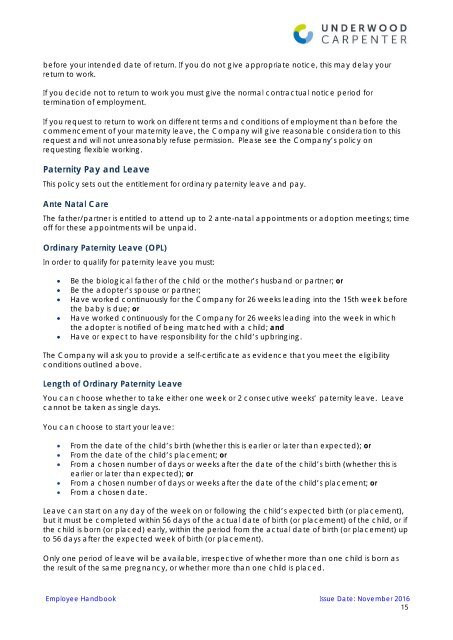Underwood Carpenter Employee Handbook - Latest 02 11 16
You also want an ePaper? Increase the reach of your titles
YUMPU automatically turns print PDFs into web optimized ePapers that Google loves.
efore your intended date of return. If you do not give appropriate notice, this may delay your<br />
return to work.<br />
If you decide not to return to work you must give the normal contractual notice period for<br />
termination of employment.<br />
If you request to return to work on different terms and conditions of employment than before the<br />
commencement of your maternity leave, the Company will give reasonable consideration to this<br />
request and will not unreasonably refuse permission. Please see the Company’s policy on<br />
requesting flexible working.<br />
Paternity Pay and Leave<br />
This policy sets out the entitlement for ordinary paternity leave and pay.<br />
Ante Natal Care<br />
The father/partner is entitled to attend up to 2 ante-natal appointments or adoption meetings; time<br />
off for these appointments will be unpaid.<br />
Ordinary Paternity Leave (OPL)<br />
In order to qualify for paternity leave you must:<br />
• Be the biological father of the child or the mother’s husband or partner; or<br />
• Be the adopter’s spouse or partner;<br />
• Have worked continuously for the Company for 26 weeks leading into the 15th week before<br />
the baby is due; or<br />
• Have worked continuously for the Company for 26 weeks leading into the week in which<br />
the adopter is notified of being matched with a child; and<br />
• Have or expect to have responsibility for the child’s upbringing.<br />
The Company will ask you to provide a self-certificate as evidence that you meet the eligibility<br />
conditions outlined above.<br />
Length of Ordinary Paternity Leave<br />
You can choose whether to take either one week or 2 consecutive weeks’ paternity leave. Leave<br />
cannot be taken as single days.<br />
You can choose to start your leave:<br />
• From the date of the child’s birth (whether this is earlier or later than expected); or<br />
• From the date of the child’s placement; or<br />
• From a chosen number of days or weeks after the date of the child’s birth (whether this is<br />
earlier or later than expected); or<br />
• From a chosen number of days or weeks after the date of the child’s placement; or<br />
• From a chosen date.<br />
Leave can start on any day of the week on or following the child’s expected birth (or placement),<br />
but it must be completed within 56 days of the actual date of birth (or placement) of the child, or if<br />
the child is born (or placed) early, within the period from the actual date of birth (or placement) up<br />
to 56 days after the expected week of birth (or placement).<br />
Only one period of leave will be available, irrespective of whether more than one child is born as<br />
the result of the same pregnancy, or whether more than one child is placed.<br />
<strong>Employee</strong> <strong>Handbook</strong> Issue Date: November 20<strong>16</strong><br />
15


